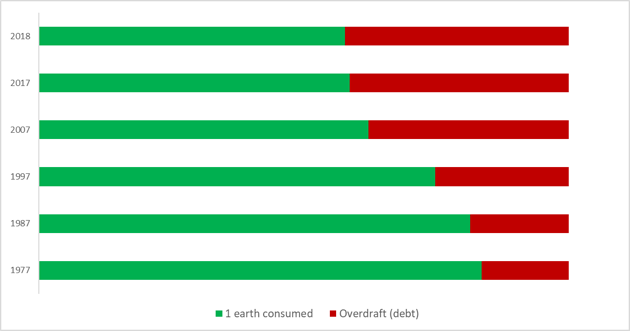After Saving Costs, Now Is The Time To Save The World!
We, as procurement professionals and as citizens, have a responsibility to take action to tackle the challenge of working sustainably.
 By Malchev/ Shutterstock
By Malchev/ Shutterstock
August 1, 2019: this could be when we reach the “Earth Overshoot Day” this year. For the rest of the year, we will be living on credit. When it comes to natural resources, that is.
“Earth Overshoot Day marks the date when humanity’s demand for ecological resources and services in a given year exceeds what Earth can regenerate in that year.” Source: OverShootDay.org
At the time of writing of this article, the actual date for Earth Overshoot Day is still unknown, but for several years in a row, we have reached the limit in early August. Based on this precedent, we can safely assume that it will be very similar this year. We may even reach it in July—a first! The situation also varies greatly by country. Some countries already reached it in February/March!
In short, this means that we would need 1.7 Earths to sustain our current level of consumption of natural resources. Considering that we only have one Earth to go around, this is a very preoccupying statistic, and even more worrying is the trend and speed at which the day is arriving earlier and earlier each year:

This situation is clearly not sustainable and we, as procurement professionals and as citizens, have a responsibility to take action to tackle this challenge.
The end of the tragedy of the commons?
“The tragedy of the commons is an economic theory of a situation within a shared-resource system where individual users acting independently according to their own self-interest behave contrary to the common good of all users by depleting that resource through their collective action.” Source: Wikipedia
To exit the tragedy of the commons, there is an urgent need for us to mobilise and act on a global scale. All economic actors have a role to play.
Governmental institutions can foster sustainability in two major ways. Firstly, by investing in businesses, research, and infrastructure and secondly, by creating regulations and policies to develop and promote socially- and environmentally-friendly practices. By adopting the right mix of carrot and stick, governments can steer behaviors and economic growth towards more favorable and sustainable outcomes.
Investors/shareholders also have an essential role to play, because by exercising their influence, they can push organizations to make sustainability a top priority. In fact, many green companies go beyond legal/governmental requirements and make sustainability the heart of their business model.
“[T]he next phase of business sustainability, what we call “market transformation,” is founded on a model of business transforming the market. Instead of waiting for a market shift to create incentives for sustainable practices, companies are creating those shifts to enable new forms of business sustainability.” The Next Phase of Business Sustainability in The Stanford Social Innovation Review (SSIR)
These companies and investors understand their obligations and interests, because the long-term survival of an organization depends on the health of its surrounding ecosystem. The concept of “Creating Shared Value” explains why a new type of investors is becoming more visible and active:
“Impact investing has become a broad umbrella that includes all investing with a focus on both financial return and social impact, but in its best form, impact investing prioritizes impact over returns and achieves outcomes that traditional investing cannot.” – Jacqueline Novogratz, founder, and CEO of Acumen, a non-profit global venture capital fund whose goal is to use entrepreneurial approaches to address global poverty
Consumers represent another powerful force. Not only do they drive demand, their buying decisions also have the power to influence what products companies produce and, to some extent, how they produce them. The growth of the “business of sustainability” and of the “circular economy” are indicators of this shift.
So, when we ask ourselves who has the power to create a more sustainable future, the answer is really: all of us. We can all exercise our influence as voters, investors, collaborators, and consumers to drive sustainable policies and practices forward.
And, when it comes to sustainability, procurement professionals have even more power than most!
Sustainable Procurement
Procurement plays a central role in transferring value from the upstream supply chain to the downstream of the chain. This means that, Procurement is the key player that enables a business to also “walk the walk” when it comes to sustainability by looking beyond prices and costs. Concepts like total cost/value of ownership (TC/VO) are not new, but they are still not commonly used, especially when integrating the impact on the ecosystem into TVO models.
For any sustainability efforts to be effective, businesses need to take a holistic approach. This is why truly “sustainable procurement” encompasses aspects related to the environment, labor & human rights, business ethics and, community development.
Many mature procurement organizations have already started to incorporate some of these aspects into their procurement approach, but the goal of these sustainability measures is often limited to “risk prevention.” Brand/reputation protection has long been a key motivating factor for organizations that have considered integrating sustainability into their approach.
And, as mentioned earlier, there is more to it than that. Sustainability can also be an engine for growth. So, to harness the full potential of sustainable procurement, procurement organizations must first understand and be aware of their role/duty, and then act accordingly to embed sustainability in all their activities. For example:
- Sourcing decisions: Include sustainability in TVO models (e.g. CO2 footprint, use of best available techniques, supplier diversity, etc.)
- Contract Management.: Incorporate sustainability clauses (e.g. reduction of waste/energy consumption, recycling, supporting disadvantaged or marginalized groups in the community, reporting on sustainability aspects, etc.)
- Supplier evaluations: Integrate quantitative and qualitative criteria into scoring models and develop real-time scorecards that also leverage 3rd party data and public sources of information
“The obligation, and the self‑interest of every company is to build a robust society.” Tim O’Reilly
Sustainability is a challenge that requires the urgent attention of all of us. As Procurement professionals, our responsibility is even greater. Therefore, we should embed sustainability in everything we do and, as much as we are able, we should become the consciences of our organizations by ensuring that sustainability is not just an empty vision, but a practice. To do this successfully, we must ensure that suppliers
- behave correctly in terms of Corporate Social Responsibility (CSR)
- use performance indicators related to Environmental, Social and Governance criteria (ESG)
Only then can we play a role similar to an investor by following SRI (Sustainable, Responsible and Impact Investing) principles when making decisions and assessing options. This represents a much better purpose and meaning than just cost savings!